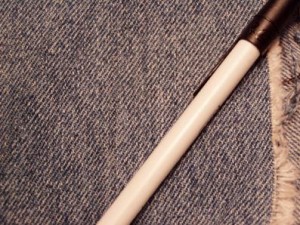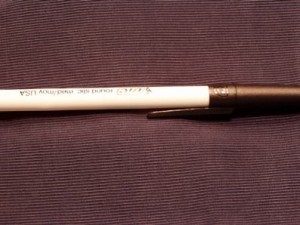 Recently, I read on another blog that I frequent the author’s question about what sort of fabric he’d gone and bought to make himself a pair of pants. Male Pattern Boldness
Recently, I read on another blog that I frequent the author’s question about what sort of fabric he’d gone and bought to make himself a pair of pants. Male Pattern Boldness
He thought it might be ‘some sort of twill’. Several of us recognized immediately that what he had was not twill but I thought that perhaps a little bit of information on what twill is…and ain’t..might be useful.
The picture at the top is a twill that is probably the most accessible and well known to all of us – and that is denim. I put the pen in the picture to draw your attention to the twill weave effect, which goes diagonally on the goods. That picture was taken straight down the leg of an old pair of blue jeans, so although the ‘straight of the grain’ is vertical, you can see that the twill effect runs diagonally.
The definition, per wiki: “Twill is a type of fabric woven with a pattern of diagonal parallel ribs.It is made by passing the weft thread over one or more warp threads and then under two or more warp threads and so on, with a “step” or offset between rows to create the characteristic diagonal pattern. Because of this structure, twills generally drape well. Examples of twill fabric are chino, drill, denim, gabardine, tweed and serge.” Twill
The one thing this definition does not mention (strangely enough) is that this structure does something else for fabrics: It makes them extremely “hard wearing”. Look at that list and what many times these fabrics are used for:
Chino: Men’s work pants and hot weather military uniforms.
Drill: Men’s work clothing where an element of protection is required; also used as coverings on items that have to take heat such as ironing board pads. Usually light colored or natural and all-cotton.
Denim: The original American work clothing: blue jeans. The original fabric came in a dual fiber form: the dark blue was cotton and the white or natural was actually wool. You can still get ‘wool denim’ clothing and fabrics from time to time and it is a fabric that the Australian Wool Board has promoted (for obvious reasons).
Gabardine: The number of various fibers that this material can be made from are legion, but it remains that this fabric is used for nicer levels of office clothing such as suits for men and women.
Serge: This fabric is not as popular in men’s suits as it once was but was considered very hard wearing; one weakness was that it had to be pressed from the back through a press cloth. The fibers in the weave are so numerous that pressing from the front caused shine.
Tweed: The best use of this form of twill is in outerwear as the fibers in the weave are relatively coarse.
So, what was the fabric that the blogger got? It certainly had a pattern of parallel ribs on it, but the direction was horizontal to the straight grain of the goods. I just made a skirt (thank you; I couldn’t find a navy pencil skirt in my size any place. I had to make one for myself) out of the same type of fabric, though mine is a mixture of cotton and silk. This weave is called “faille” and can be found in many different fibers. The ribs are more pronounced than in a twill (besides the direction being totally different) and this gives the fabric entirely different qualities in terms of draping, durability and so on. In general, it is seen as a dressier fabric than twills are and is generally not used in items such as pants, where durability in the seat and inner leg areas is a concern.
In general, it is seen as a dressier fabric than twills are and is generally not used in items such as pants, where durability in the seat and inner leg areas is a concern.
So, from a ‘bang for your buck’ aspect, what’s your best choice? Well, for rough outdoor work clothing, denim and drill can’t be beaten. For suits with slacks, gabardine is best (and even better if you get it in ‘worsted wool’ or a ‘worsted wool blend’ as the worsted processing produces fibers with a hard finish, which makes the fabric even more durable). For women’s suits and dresses, gabardine is a very good choice as gabardine (especially in lighter weights) has a very nice drape but will also tailor well. For outerwear, heavier gabardines and tweeds are very good choices. Remember – hold up the fabric in the item up to the light and move one hand up and down so that the light plays across the face of the fabric and you’ll be able to see the diagonal rib effect. That way, you’ll know you have a true twill.

Woot! As soon as I saw the photo, I said “Faille!”
All those years making theatrical costumes taught me a thing or two.
Interesting, I’ve always called that weave “ottoman”! Maybe because I know it from shopping for my husband and men won’t buy faille pants? Or are they the same thing? I do have to note that his (cotton) ottoman-weave pants (they’re a jeans cut) are incredibly durable so far, although they’ve only seen maybe 3 years of wear now.
I’m puzzled that a man bold enough to make pants would not know fabric (or be told at the store.) I was reminded of a young man in my college days who proudly told me that he’d made his girlfriend a skirt, which he was about to present as a gift. When I asked him, “What kind of fabric did you use?” he replied, “It’s called lining”.
Duchesse: Well, the blogger in question is famous (notorious?) for his rather idiosyncratic fabric shopping methods and venues. I think perhaps this particular piece of fabric was thrifted. On the other hand, I have to say that the sheer amount of cultural and technical knowledge about fabric and clothing that has been lost over the past 25 years is mindboggling. The number of wool fabrics, for example, which are basically not being made any longer (because consumers don’t request them because they don’t know anything about them, therefore manufacturers don’t use them, therefore mills don’t make them) could go on for pages. When Michelle Obama walked out at the Inauguration in a dress made with wool lace from Switzerland, the fashion press was totally puzzled. Wool lace? Who knew? There is such a thing as ‘wool satin’ (sometimes referred to as ‘satin faced wool’) which is a type of very dressy gabardine. I have a book entitled “The Way We Wore” written by a former Hollywood actress where she details practically every outfit in every photo in the book – the number of names of fabrics I did not recognize was pretty humbling. I recently saw an online retailer with wool crinkle gauze fabric – which looked as if it would be splendid for a fall/winter/early spring dress. The other thing is this – the advent of the ‘big box fabric cum crafts’ store has basically been another nail in the coffin of not only the availability of fabrics but also basic fabric knowledge. These stores pay poorly, don’t train, don’t hire people on the basis of fabric or sewing knowledge and so on. Go into a store like that and ask whether they carry ‘faille’ and you would not find anyone who would even know what faille is. “Where do you have the scrapbooking supplies?” – yes, you’d definitely find someone who could point out that aisle. Locally owned fabric stores that actually have people in them who sew and who know fabrics are few and far between.
It’s really tough to find ANYthing at the “Crafty Box” that I’d want to use for a garment – other than cookie cutter prom dresses. uh … way past prom time, although daughter #2 is marrying …. So freakin’ frustrating! Hurray for the internet. Although, even there (here?) I still have to cross my fingers and hope that what looks good on my monitor actually is good. This is one of my pet rants, obviously.
P.S.: Welcome back, Aunt Toby! Looks like the PT aka Torture is doing it.
Okay, so does this mean I was right to think this fabric was a twill weave?
If the ridges go diagonally across the fabric (in comparison to the selvage) it’s a twill.
I know faille, that dates me, I guess. But– for all your comments– twill is not an obscure or rare fabric, is it?